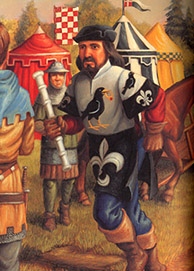

The von Döring/Doering Family
Prepared and researched by Margaret Odrowaz-Sypniewski
A special thanks to John Rohde of the UK and Klaus Liwowsky of Germany for providing me with the armorial information.

DÖERING COAT OF ARMS:
The above coat of arms represents: A dove with a ring in his mouth ("dove-ring")
In heraldic terms: "on a sable field, upon a green hill proper, showing the furrow of the plow is a bird of unknown type (but looks to be morning dove), facing dexter; holding a ring in its beak. To which the helmet has a crest coronet, upon which stands a bird of the same type as the shield. The mantling is azure/blue-lined with argent (silver or white).

VON DÖERING COAT OF ARMS:

This coat of arms is found on a Luneberg Church link. It was assigned to the patrician (upper class) family of von Doring. This family lived in the Luneberg area until the 18th century. Luneberg was located in Hanover, Germany (see link below).
The symbol of the Grail Knights was the turtle-dove, and this was an accepted symbol for the Holy Ghost. In Matthew 3:16: "The Spirit of God descendin like a dove."
This coat of arms was granted in September 27, 1630, on the same date as the Saxon/Prussian (nobility of the Holy Roman Empire) version of this arms, both feature a lion. The difference is that the Prussian lion is gold. The lion is also the symbol of Thuringia.
The version above is a silver (argent = white) lion on
a gules/red shield (l'ecu).
Its crest displays a lion on a supportant with a circular screen on top. The shield is a circular screen decorated with three plumes. Each of the three plumes alternate between silver (argent=white) and gules (red). On the helmet, the supportant is also striped with argent and gules and is located on the top of the helm. These are components are atop the helm as a headdress (Riestrap, J.B. Armorial General. Vol. 1 A-K, Baltimore: Clearfield Company, Inc. 2003 (reprint), p. 555).
ORIGINS

In 1580, there is a listing for the coat of arms of a Lucas and David Doring. This was recorded on Augusat 17, 1580, in Prague, Bohemia (later Czech Republic).
Von Döering seems to have its roots in Thuringia, located between Hessen and Lower Saxony in the west and Saxony in the east. This area was originally the kingdom of the Germanic Hermunderen, the area which was conquered by the Franks and the Saxons in 531 A.D. In the 11th century, the Ludowinger dynasty ruled Thuringia. The castle Wartburg was built in Thuringia, in 1067, by Landgrave Ludwig the Springer. Ludwig's wife was Saint Elizabeth. Elizabeth was the daughter of the Hungarian king. She was said to host the medieval singing contests, for which this area is famous. Poetry, you must remember, began as singing, so these contests were frequented by troubadors. In their early history those of the name von Doering held a status and influence that rivalled the landed aristocracy. Many of their family were elevated to nobility, as they gave service to the Church, were politics, and achieved economic wealth. One of the first recorded of this name was Dietric von Duering of Bremen, in 1140.
FREQUENCY OF THE NAME DÖERING:
RELATED LINKS:
According to Sl~ownik Nazwisk there are approximately 527 people with the name Doering in Poland:
VARIATIONS
Here are some examples of the variations that have ocurred in the spelling of this name: Duering, During, Dueringe, Dueringen, Duehring, Duhring, Döring, Doring, Doehring, Duehrig, Duerich, Doerich, Dieruich, Dieringer, Diericke, Dierecke, Doringk, Doeringk, Duhringer, Duringer, Doringer, Doeringer, and von Döering.
Doering is an ethnic name for someone from Thuringia (German Thüringen). The region is thus named because its former occupation by the Thuringii, a Germanic tribe. Von Doering is from a personal name based on cognate of turren "to dare".
HISTORICAL INFORMATION
After the fall of the Ludowinger dynasty, the House of Wettin became the rulers of Thuringia and ascended to the throne of Saxony. In 1485, Thuringia was divided into four parts: Sachsen-Weimar, Sachsen-Altenburg, Sachsen-Coburg, and Sachsen-Meiningen. The Thuringian Forest are said to be the most beautiful of central Germany. Martin Luther was said to have stayed at Wartburg Castle, after being excommunicated by the Pope.
MORE ON WARTBURG CASTLE:
The early members of the Doering family lived in Lockstede and Dueringen in Bremen. They owned the estates of Ehmbsen, Ahlerstedt, Mottenshof and Horneburg near Hanover, Germany (today). Branches of this family had estates in Sweden, Denmark, and Hanover. (in the 15-17th centuries). One member, Baron Johann Christoph von Duering was enobled in Sweden in 1719. He was Major-General in the Swedish Army.
MORE ON BREMEN:
The von Döerings had estates in Saxony called Boehlen, Seelingstadt, Muelbach, Trautzschen, and Roitzsch. They then moved to Bavaria and Prussia. Today my own family lives in the Bavarian "Black Forest" area where they own a large inn. Johann Döring was the Royal Danish financier at Kiel. D. David Dö (d.1636) was Lord of Boehlen, was enobled in 1630 in reward for his services as royal advisor to the Princes of Saxony. He also was Lord of the estates of Seelingstadt, Mulhlbach, and Trautzschen. Later, he was Privy Concillor and advisor on mines and resources. He worked with Prince Johann Georg I of Saxony. Johann's sons were learned men. David II was a Saxon advisor. and Chancellor of Wurzen College. Johann's grandson, Erich Frederick von Döering, was Royal Polish and Saxon Justice Advisor and later Privy Councillor and Chancellor of the college at Naumberg. Thuringia remained a free state, until 1952, when it became part of the German Democratic Republic. Emigration from Germany began after 1650. Many Germans came to Canada and the United States.
GENERATION ONE
August Stempnakowski married Anna von Döering They were from West Prussian Germany. Anna was reputed to be a French teacher in Alsace-Lorraine.
MORE DOERING LINKS:
